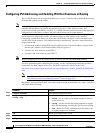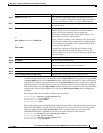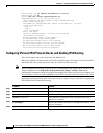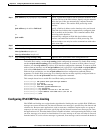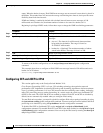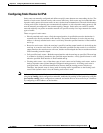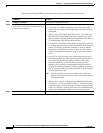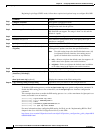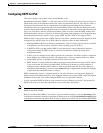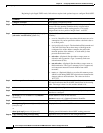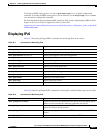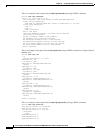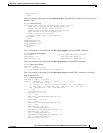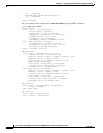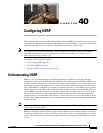
39-24
Cisco Catalyst Switch Module 3110 and 3012 for IBM BladeCenter Software Configuration Guide
OL-12189-01
Chapter 39 Configuring IPv6 Host Functions and Unicast Routing
Configuring IPv6
Beginning in privileged EXEC mode, follow these required and optional steps to configure IPv6 RIP:
To disable a RIP routing process, use the no ipv6 router rip name global configuration command. To
disable the RIP routing process for an interface, use the no ipv6 rip name interface configuration
command.
This example shows how to enable the RIP routing process cisco, with a maximum of eight equal-cost
routes, and enable it on an interface:
Switch(config)# ipv6 router rip cisco
Switch(config-router)# maximum-paths 8
Switch(config)# exit
Switch(config)# interface gigabitethernet2/0/11
Switch(config-if)# ipv6 rip cisco enable
For more information about configuring RIP routing for IPv6, see the “Implementing RIP for IPv6”
chapter in the Cisco IOS IPv6 Configuration Library at this URL:
http://www.cisco.com/en/US/products/sw/iosswrel/ps5187/products_configuration_guide_chapter0918
6a00801d6601.html
Command Purpose
Step 1
configure terminal Enter global configuration mode.
Step 2
ipv6 router rip name Configure an IPv6 RIP routing process, and enter router
configuration mode for the process.
Step 3
maximum-paths number-paths (Optional) Define the maximum number of equal-cost routes
that IPv6 RIP can support. The range is from 1 to 64, and the
default is 4 paths.
Step 4
exit Return to global configuration mode.
Step 5
interface interface-id Enter interface configuration mode, and specify the Layer 3
interface to configure.
Step 6
ipv6 rip name enable Enable the specified IPv6 RIP routing process on the interface.
Step 7
ipv6 rip name default-information {only |
originate}
(Optional) Originate the IPv6 default route (::/0) in the RIP
routing process updates sent from the specified interface.
Note To avoid routing loops after the IPv6 default route (::/0)
is originated from any interface, the routing process
ignores all default routes received on any interface.
• only—Select to originate the default route, but suppress all
other routes in the updates sent on this interface.
• originate—Select to originate the default route in addition
to all other routes in the updates sent on this interface.
Step 8
end Return to privileged EXEC mode.
Step 9
show ipv6 rip [name] [interface interface-id]
[database] [next-hops]
or
show ipv6 route rip [updated]
Display information about IPv6 RIP processes.
Display the contents of the IPv6 routing table.
Step 10
copy running-config startup-config (Optional) Save your entries in the configuration file.



